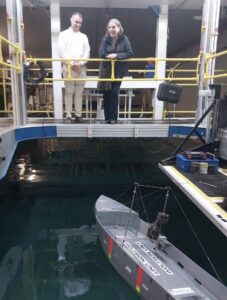
NFFO risk, safety and training lead Charles Blyth and Tina Barnes, impact director at The Seafarers’ Charity, during the trials at the Wolfson Unit.
Initial tank test results suggest a sea-state-based approach to certification may be better for some small vessels than blocking the scuppers – and could feed into revisions to the under-15m code
By Julia Gosling
Last year, The Seafarers’ Charity and the Southampton Marine and Maritime Institute (SMMI) began a two-phase collaborative project with the Wolfson Unit, a marine technology consultancy within the University of Southampton, and the NFFO.
With more than 100 years’ combined experience in vessel design and stability, Wolfson Unit engineers are respected leaders in the fields of marine technology and small craft safety. The project is supported by Charles Blyth, the NFFO risk, safety and training lead, and is part of The Seafarers’ Charity’s strategic partnership with the NFFO which aims to improve fishing safety.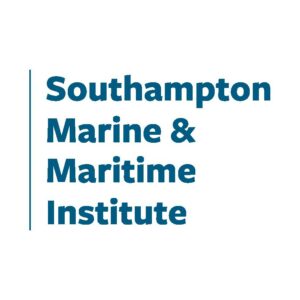
As every FN reader will know, under-15m vessels – which make up 90% of the UK fishing fleet – have historically seen a high incidence of capsize issues at sea, often with tragic consequences.
The Wolfson Unit has produced new experimental evidence on the survivability in waves of a typical 10m fishing monohull, in relation to the stability criteria and guidance presented in the current UK Code of Practice for small fishing vessels. The objectives were twofold:
- To establish the level of safety from capsizing enabled by the Wolfson Stability Method over a range of load conditions
- To determine the survivability in waves and, therefore, the relative safety from capsizing of an unmodified decked design (with a sealed deck and scuppers/freeing ports fitted) and an equivalent open boat (with internal deck drains, a sump and pump arrangement fitted and freeing ports blocked up)
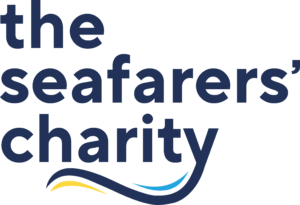 A 1:6 scale model was tested in Southampton University’s Boldrewood Towing Tank facility. Testing in the tank makes for an interesting spectator sport, and enables researchers to push model vessels to the limit and beyond, without risking real boats and real people. Representatives of the Maritime and Coastguard Agency attended these tests as observers, and the Royal Institution of Naval Architects (RINA) has also received the results for consideration.
A 1:6 scale model was tested in Southampton University’s Boldrewood Towing Tank facility. Testing in the tank makes for an interesting spectator sport, and enables researchers to push model vessels to the limit and beyond, without risking real boats and real people. Representatives of the Maritime and Coastguard Agency attended these tests as observers, and the Royal Institution of Naval Architects (RINA) has also received the results for consideration.

For the tests, a 1:6 scale model of a typical monohull was constructed…
The Wolfson report states that ‘at the combinations of regular waves and load condition tested, the decked vessel configuration appeared just as vulnerable to capsizing as the ‘equivalent’ open vessel in short, steep waves, representing coastal sea states where inshore fishing boats would typically operate’.
Matteo Scarponi, the Wolfson Unit consultant who led this project, added: “This finding may lead to consideration of the alternative solutions enabled by the Code of Practice – for example, a risk-based, conditional certification whereby certain low-risk vessels could be allowed to operate within the sea-state limits advised in the Wolfson Stability Guidance.”
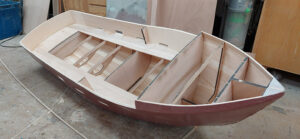
… carefully replicating its stability characteristics.
The Wolfson report includes recommendations to:
- Evaluate the merit of fitting non-return flaps to the freeing ports of existing low-freeboard fishing boats
- Consider replacing the Code of Practice distance-based restrictions with sea-state-based guidance according to the Wolfson Method
- Permit decked monohulls similar to the test vessel to demonstrate Code of Practice compliance via alternative routes, as opposed to encouraging their conversion to open boats.
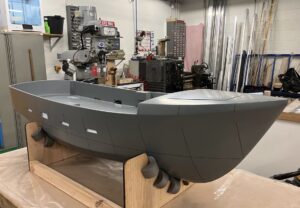
The completed hull had a number of freeing ports. These were blocked up for some of the tests, with the deck opened up and a scaled-down bilge pump operating in the hull.
RINA has recently commented on the report, and the Wolfson Unit has provided RINA with a written response that expands on the test method, results and analysis. It is expected that this discussion will be published in due course as an addendum to the Wolfson report.
FIND OUT MORE
The full Phase 1 research report is now available to download at: bit.ly/3T4Hgjr
How the tests were carried out
A 1:6 scale physical model vessel was built, and load conditions were identified whereby the decked vessel would fail a statutory stability assessment but, according to the Wolfson Method, could still be operated safely in benign sea states.
Physical testing at these conditions confirms the merit of a sea-state-based allowance, as all capsize events occurred at combinations of stability and wave height deemed unsafe by the Wolfson Method.
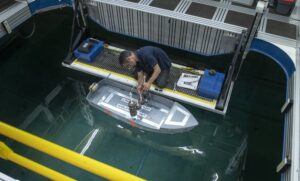
The finished model could be carefully ballasted to simulate all sorts of amendments to the vessel’s stability, testing different loading scenarios and sea conditions.
The decked model was then reconfigured as an open boat by blocking up its freeing ports, installing a deck drainage system designed to the current MCA Code of Practice and fitting a bilge pump of the appropriate capacity. The open boat model was then tested in the same conditions as the decked vessel.
Both the decked and the open vessel configuration capsized in short, steep regular waves approximately 1.1m to 1.2m in height. In a near-accident loading condition, the decked model also capsized within the wave height range 1.3m to 3.0m, whereas the open model survived.
At the MCA minimum rating of 190 litres per minute, the bilge pump appeared adequate to disperse the excess floodwater and therefore prevent a capsize. However, in a scenario with a malfunctioning bilge pump, the number of capsize events could potentially rise from two to eight out of the 31 open boat runs performed.
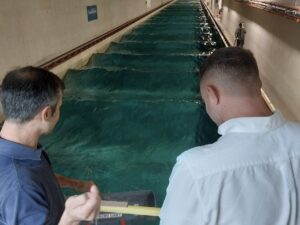
The huge 138m tank at Southampton University can simulate different sea states and wave conditions, including the steep short waves often encountered by inshore fishermen in the southern North Sea and the Channel, as well as the much larger swells experienced on open western coasts.
Further tests in 2024
The NFFO will continue working with the Wolfson Unit and conduct further testing in 2024, looking at an affordable and accessible solution for low-freeboard vessels.

There she goes! Both versions of the scale model capsized in the worst sea conditions simulated; failure of the bilge pumps would also greatly increase the likelihood of capsize.
This will include further research on the impact of a reduced number of freeing ports, and the impact this may have on vessel survivability. Charles Blyth said: “We often hear from fishermen that the current 2% requirement for freeing port area lets too much water onto the deck, and may be detrimental to stability. This appears to be supported by the first phase of testing, so it is important to investigate this further.”
This first phase of testing used a monohull fishing vessel, and The Seafarers’ Charity has funded a second phase of testing involving the construction of a catamaran model, in order to accurately represent the typical range of UK inshore fishing vessel types in the research. This should be completed this spring.
This story was taken from the latest issue of Fishing News. For more up-to-date and in-depth reports on the UK and Irish commercial fishing sector, subscribe to Fishing News here or buy the latest single issue for just £3.50 here.
Sign up to Fishing News’ FREE e-newsletter here.








